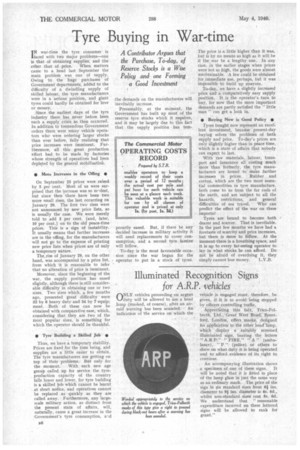Tyre Buying in War-time
Page 32

If you've noticed an error in this article please click here to report it so we can fix it.
A Contributor Argues that the Purchase, To-day, of Reserve Stocks is a Wise Policy and one Forming a Good Investment
I N war-time the tyre consumer is faced with two major problems—one is that of obtaining supplies, and the other that of price. When matters came to a head last September the main problem was one of supply. Owing to the huge purchases of Government departments, added to the difficulty of a dwindling supply of skilled labour, the tyre manufacturers were in a serious position, and giant tyres could hardly be obtained for love or money.
Since the earliest days of the tyre industry there has never before been such a supply crisis as then occurred. In addition to tremendous Government orders there were many vehicle operators who were ordering larger stocks than ever before, fully realizing that price increases were imminent. Furthermore, all this great production effort had to be made by factories whose strength of operatives had been depleted by the general mobilization.
• More Increases in the Offing • On September 25 prices were raised by 5 per cent. Most of us were surprised that the increase was so m-,dest, but since then there have been two more small rises, the last occurring on January 29. The first two rises were not announced by new price lists, as is usually the case. We were merely told to add 5 per cent. (and, later, 10 per cent.) on to the old peace-time prices. This is a sign of instability. It usually means that further increases are in the offing, for the manufacturers will not go to the expense of printing new price lists when prices are of only a temporary nature.
The, rise of January 29, on the other hand, was accompanied by a price list, from which it is reasonable to infer that no alteration of price is imminent.
Moreover, since the beginning of the war, the supply position has eased slightly, although there is still considerable difficulty in obtaining one or two sizes. Two sizes which, a few months ago, presented great difficulty were 32 by 6 heavy duty and 34 by 7 equipment. Both of these can now be obtained with comparative ease, which, considering that they are two of the most popular sizes, is something for which the operator should be thankful.
• Tyre Building a Skilled Job •
Thus, we have a temporary stability. Prices are fixed for the time being, and supplies are a little easier to obtain. The tyre manufacturers are getting on top of their problems. But only for the moment. With each new age group called up for service the tyreproduction capacity of the country falls lower and lower, for tyre building is a skilled job which cannot be learnt at short notice, and operatives cannot be replaced as quickly as they are called away. Furthermore, any largescale military action, as distinct from the present state of affairs, will, naturally, cause a great increase in the Government's tyre consumption, ad
the demands on the manufacturers will inevitably increase.
Presumably, at the moment, the Government has built up most of the reserve tyre stocks which it requires, and it may be largely due to this fact that the supply position has tern porarily eased. But, if there be any decided increase in military activity it will need replacements to cover consumption, and a second tyre famine will follow.
To-day is the most favourable occasion since the war began for the operator to put in a stock of tyres. The price is a little higher than it was, but is by no means as high as it will he if the war be a lengthy one. In any case, in the earlier stages when prices were not so high, the goods were almost unobtainable. A few could be obtained for immediate use, perhaps, but it was impossible to build up reserves.
To-day, we have a slightly increased price and a comparatively easy supply position. It is the operator's turn to buy, for now that the more important demands are partly satisfied the " little man ".can get a look in.
• Buying Now is Good Policy • Tyres bought now represent an excellent investment, because present-day buying solves the problems of both supply and price. To-day's prices are only slightly higher than in peace time, which is a state of affairs that nobody can expect to last.
With raw materials, labour, transport and insurance all costing much more than formerly, the tyre manufacturers are bound to make further increases in prices. Rubber and cotton, which are the two most essential commodities in tyre manufacture, both come to us from the far ends of the earth, and are subject to all the hazards, restrictions, and general difficulties of sea travel. Who can predict the effect of the war on these imports?
Tyres are bound to become both dearer and scarcer. That is inevitable. In the past few months we have had a foretaste of scarcity and price increases, but there is more to follow. At the Moment there is a breathing space, and it is up to every far-seeing operator to lay in what stocks he can afford. Do not be afraid of overdoing it, they simply cannot lose money. L.V.B.




























































